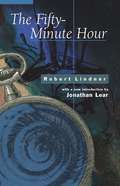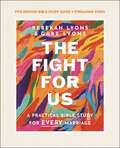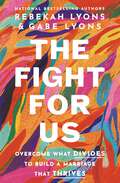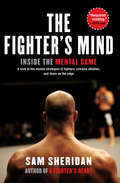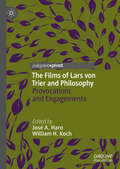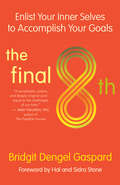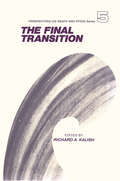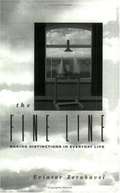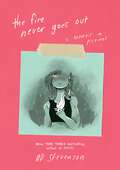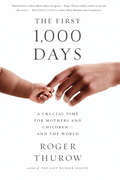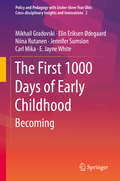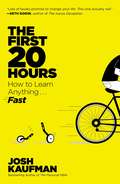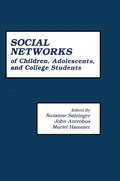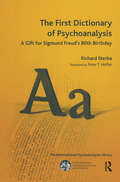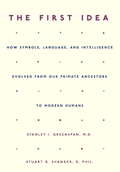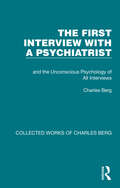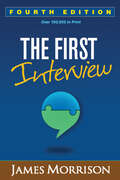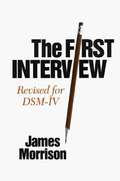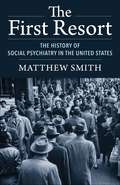- Table View
- List View
The Fifty-Minute Hour
by Jonathan Lear Robert Lindner"A fascinating mixture of traditional psychoanalytic thinking with clinical strategies that even today would be considered creative and controversial, The Fifty-Minute Hour has never failed to capture the imagination. . . . No student's education in psychotherapy is complete without reading this book. Decades after its original publication, it still stands as a pioneering landmark in the history of psychotherapy."-John Suler
The Fight for Us Bible Study Guide plus Streaming Video: A Practical Bible Study for Every Marriage
by Gabe Lyons Rebekah LyonsDiscover why you fight, how you fight, and how to overcome toxic patterns so that you can stop fighting with your spouse and start fighting for your spouse.Strengthen your marriage and rediscover the power of "us" with this five-week video Bible study (video access included) from Rebekah and Gabe Lyons as they introduce you tokey practices to help you halt the "dysfunction dance", support your spouse in their calling, and build healthier rhythms.Together, Rebekah and Gabe draw on their mental health coaching and marriage counseling expertise (not to mention their personal experience from twenty-seven-years of marriage) to help you breathe new life into your own marriage.Wherever you are on your marital journey, The Fight For Us Bible Study Guide invites you and your spouse to step into a deeper, intentional fight—for each other, for unity, and for the future of your marriage.This study guide has everything you need for a full Bible study experience, including:The study guide itself—with video notes, discussion questions, personal and couples reflection sections, and prayer prompts. An individual access code to stream all video sessions online. (You don't need to buy a DVD!) Sessions and video run times:Introduction and the Fight (22:00)Understanding Our Feelings and Origin Stories (31:00)Community and Calling (28:00)From Divided to United (27:00)Rhythms for a Thriving Marriage (22:00) Streaming video access included. Access code subject to expiration after 12/31/2030. Code may be redeemed only by the recipient of this package. Code may not be transferred or sold separately from this package. Internet connection required. Void where prohibited, taxed, or restricted by law. Additional offer details inside.
The Fight for Us: Overcome What Divides to Build a Marriage That Thrives
by Gabe Lyons Rebekah LyonsAn insightful, powerful path forward for couples, whether you're in a struggling marriage or simply looking for ways to enhance and strengthen your relationship.Marriage is hard for all kinds of reasons--financial struggles, parenting styles, personality differences, difficult circumstances. It's easy to drift apart, walking through life more as roommates than partners. But there's so much more for your marriage. The Fight for Us offers biblical wisdom and encouragement, as well as practical guidance, that will give you the confidence you need to cultivate the happy and healthy marriage you long for.Rebekah and Gabe Lyons shepherd you as ones who have been there--many times--in their twenty-seven-year marriage, while also drawing on their mental-health coaching and marriage-counseling expertise to help you breathe new life into your marriage. The Fight for Us will guide you to:Discover why you fight, how you fight, and how to overcome toxic patterns to fight wellRenew your commitment to love, care for, and show grace to your spouseRelinquish coping mechanisms and/or addictions that have come between youUnderstand your spouse's needs while still validating your ownEstablish goals and rhythms that will deepen your friendship and intimacy as a coupleAnd, most of all, lean on the One who fights for you and your marriage Whatever your reason for fighting for your marriage, The Fight for Us covers it all: community, health, money, parenting, career, sex, conflict, and spirituality. Your journey toward a growing, healthy, thriving marriage starts here.
The Fighter's Mind: Inside the Mental Game
by Sam SheridanFrom the acclaimed author of A Fighter’s Heart comes an “entertaining and enlightening” look inside the mental game of mixed martial arts fighting (Dave Doyle, Yahoo! Sports). In his acclaimed national bestseller, A Fighter’s Heart, Sam Sheridan took readers with him into the dangerous world of professional fighting. From a muay Thai bout in Bangkok to Iowa, where he fought the toughest mixed martial arts stars, Sheridan threw himself into a quest to understand how and why we fight. In The Fighter’s Mind, Sheridan explores the mental discipline required of an elite fighter. In his training, Sheridan heard time and again (in Yogi Berra fashion) that “fighting is ninety percent mental, half the time.” But what does this mean, exactly? To uncover the secrets of mental strength and success, Sheridan interviewed dozens of the world’s most fascinating and dangerous men. He spoke with celebrated trainers Freddie Roach and Greg Jackson; champion fighters Randy Couture, Frank Shamrock, and Marcelo Garcia; ultrarunner David Horton; chess prodigy (and the inspiration for Searching for Bobby Fischer) turned tai chi expert Josh Waitzkin; and the legendary wrestler Dan Gable, among others. “Fantastic . . . One of the best MMA books I’ve ever read, and I’ve certainly read my fair share.” —Eric O’Brien, “Way of the Warrior,” ESPN radio “You don’t have to care about fighting, or even know that MMA stands for mixed martial arts, to find insights into human behavior in Sam Sheridan’s The Fighter’s Mind.” —David M. Shribman, Bloomberg
The Films of Lars von Trier and Philosophy: Provocations and Engagements
by José A. Haro William H. KochThe films of Lars von Trier offer unique opportunities for thinking deeply about how Philosophy and Cinema speak to one another. The book addresses von Trier’s films in order of their release. The earlier chapters discuss his Golden Heart trilogy and USA: Land of Opportunities series by addressing issues of potential misogyny, ethical critique, and racial justice. The later chapters focus on his Depression Trilogy and address the undermining of gender binaries, the psychoanalytic meaning of the sacrifice of children and depression, and philosophical questions provoked by the depiction of the end of the world. Taken together, the volume explores the topics of Philosophical Psychology, Social Theory, Political Theory, Theories of the Self, Philosophy of Race, and Feminist Thought, and opens a conversation about von Trier’s important work.
The Final 8th: Enlist Your Inner Selves to Accomplish Your Goals
by Bridgit Dengel GaspardBlocked? A Revolutionary Guide to Getting Unstuck Author Bridgit Dengel Gaspard coined the term &“the final eighth&” to describe a phenomenon she experienced herself and observed in others: talented, energetic, motivated people accomplish many steps toward a goal (seven-eighths of it) but then are mysteriously stalled. Practical tips and pep talks don&’t work because the problem — and the solution — lies deeper. While the conscious, everyday self says, &“I want this,&” other inner selves worry that success will put them in some kind of danger. The powerful secret? Not every part of you wants what you think you want! The innovative technique of voice dialogue will help you communicate with your alter egos, whatever your goal is. In the process, you&’ll discover and liberate inner &“wise counselors, canny advisers, and magical sages,&” transforming them into valuable allies who&’ll help you finally achieve your goals.
The Final Crossing: Learning to Die in Order to Live
by Scott Eberle"The River Styx isn't far ahead. When it's time for the final crossing, doc, I want you there at the helm." Hearing these words from Steven Foster, hospice physician Scott Eberle unhesitatingly responded, "I give you my word, Steven. If it's within my powers, I'll be there." In a matter of weeks, Steven would be dead, having succumbed to a genetic lung disease at the young age of 64. THE FINAL CROSSING is the story of the journey these two people made together across the river that separates the living from the dead. Steven and his wife, Meredith, had spent nearly thirty years exploring, creating, and enacting wilderness rites of passage - a form of symbolic death. Scott had spent nearly twenty years learning to help others through the rite of passage that is physical death, and more recently he had also begun working as a wilderness guide. As Scott writes in the book, "while symbolic dying and literal dying are obviously not the same, they are deeply connected". During Steven's final days, the lessons they taught each other -- about symbolic and physical death -- were profound. As an old medieval prayer says, "To be blessed in death, one must learn to live. To be blessed in life, one must learn to die". Visit www.thefinalcrossing.com. "This book is itself a right of passage. Extraordinary insights shared by two remarkable people, one dying, the other the inner life and decisions of the physician and friend attending this fine fellow preparing to head into death. This is the best work of its sort I have come across. There are so many levels, so many books in this book that it might well become a teaching text in many classrooms". Stephen Levine, author of "Who Dies?," "Healing into Life and Death" and "A Year to Live".
The Final Transition (Perspectives On Death And Dying Ser. #Vol. 5)
by Richard A. KalishThis text is not just another reader on death, but rather a carefully developed book, created specifically for those persons whose major interests are either death education, death counseling, or, of course, both. The audience which this book addresses include: persons who have had either experience in death counseling or education or previous academic work; those who are contemplating professional work in the field or who are already in the process of developing this area as one of their fields of competence; and individuals who are already either counselors or educators or otherwise involved in the fields of mental health or education and who wish to learn more about the relationship of death and grief to their work.
The Financial Wisdom of Ebenezer Scrooge: 5 Principles to Transform Your Relationship with Money
by Brad Klontz Ted Klontz Rich KahlerThe Today Show, NPR, and The Wall St. Journal Now, as the United States--and much of the world--braces for a crash, the time-tested "Financial Wisdom of Ebenezer Scrooge" will help anyone stand on solid financial footing, securing prosperity for themselves and a healthy financial legacy for those they leave behind.
The Financial and Economic Crises and Their Impact on Health and Social Well-Being (Policy, Politics, Health and Medicine Series)
by Vicente Navarro Carles MuntanerThis volume provides a timely collection of the most germane studies and commentaries on the complex links between recent changes in national economies, welfare regimes, social inequalities, and population health. Drs. Vicente Navarro and Carles Muntaner have selected 24 representative articles, organized around six themes, from the widely read pages of the International Journal of Health Services (2006-2013) - articles that not only challenge conventional approaches to population health but offer new insights and robust results that critically advance public health scholarship. Part I applies a social-conflict perspective to better understand how political forces, processes, and institutions precede and give rise to social inequalities, economic instability, and population health. The need to politicize dominant (neoliberal) ideologies is emphasized, given its explanatory power to elucidate unequal power relations. The next four parts focus on the health impacts of growing inequalities and economic decline on government services and transfers (Part II); labor markets and employment conditions (Part III); welfare states and regimes (Part IV); and social class relations (Part V). Part VI advocates for a more politically engaged approach to population health and presents alternative solutions to achieving egalitarian outcomes, which, in turn, improve health and reduce health inequalities. Taken together, the works in this volume reflect IJHS 's collective commitment to publishing high-impact studies, inspiring fruitful debates, and advancing the discipline in new and essential ways. Emerging and established researchers as well as students and professionals committed to health equity matters will benefit from this book's astute contributions.
The Fine Line: Making Distinctions in Everyday Life
by Eviatar ZerubavelEviatar Zerubavel argues that most of the distinctions we make in our daily lives and in our culture are social constructs. He questions the notion that a clear line can be drawn to separate one time or object or concept from another, and presents witty and provocative counterexamples in defense of ambiguity and anomaly.
The Fire Never Goes Out: A Memoir in Pictures
by Noelle StevensonFrom ND Stevenson, the New York Times bestselling author-illustrator of Nimona, comes a captivating, honest illustrated memoir that finds him turning an important corner in his creative journey—and inviting readers along for the ride.In a collection of essays and personal mini-comics that span eight years of his young adult life, author-illustrator ND Stevenson charts the highs and lows of being a creative human in the world.Whether it’s hearing the wrong name called at his art school graduation ceremony or becoming a National Book Award finalist for his debut graphic novel, Nimona, ND captures the little and big moments that make up a real life, with a wit, wisdom, and vulnerability that are all his own.Named one of Bank Street College of Education's Best Children’s Books of the Year!
The First 1,000 Days: A Crucial Time For Mothers And Children--and The World
by Roger ThurowBased on compelling new scientific and social science research on early childhood malnutrition, a new generation of activists have been inspired to re-think old approaches to 'feeding the world. ’ The new target in the assault on malnutrition: the first 1,000 days of a child’s life, starting from gestation. Proper nutrition during the 1,000 days can profoundly influence an entire life, particularly an individual’s ability to grow, learn and work. It can also determine a society’s long-term health and prosperity. The 1,000 days is where everyone starts out equal, and where the world’s inequalities begin. On Sept. 21, 2010, during the United Nations General Assembly, US Secretary of State Hillary Clinton joined with her counterpart in the Irish government to launch the Scaling Up Nutrition (SUN) initiative. It demanded national leaders across the world to commit to the 1,000 days and work together across issues and sectors to improve nutrition. "There is a unique convergence of the science and research about what works and what needs to be invested in,” Clinton said. "It is now time for us to get into action. ” By the end of 2013, 45 countries in the developing world embraced SUN, and nearly 100 humanitarian organizations joined in partnership. For SUN to truly rise, however, it demanded a fresh development model anchored in a new ethic of cooperation in the oft-dysfunctional humanitarian community. Over the previous decades, most every organization active in this realm had mainly fixated on its own pet projects, which were almost always deployed in scattershot isolation from others. Nutrition, for example, had traditionally been seen as a health issue, not an agriculture issue or a development/poverty-reduction issue. Clean water had its own cheering section, as did sanitation, as did education, as did infrastructure. The 1,000 days offered a time and place where all these elements of development could come together--where they needed to come together. But would they? In 1,000 Days, award-winning journalist and world hunger advocate Roger Thurow examines the importance of the 1,000 days and the progress of the new global movement to end early childhood malnutrition. Thurow zeroes in on particular initiatives involving a small group of mothers and children in four diverse places--a small village in northern Uganda, Uttar Pradesh in India, Quetzaltenango in the western highlands of Guatemala, and Chicago, Illinois. The narrative will open a new front in the great aid debate, providing a fresh answer for the contentious question: Why haven’t the hundreds of billions of dollars spent on development aid been more effective? Because so very little of it has been focused on nutrition and the 1,000 days. And what, once we do focus on them, are the obstacles to success in various contexts and cultures? Through the inspiring and heartbreaking stories of mothers, and activists, trying to surmount the odds, Thurow reveals the stumbling blocks on our path to a better future.
The First 1000 Days of Early Childhood: Becoming (Policy and Pedagogy with Under-three Year Olds: Cross-disciplinary Insights and Innovations #2)
by E. Jayne White Jennifer Sumsion Elin Eriksen Ødegaard Carl Mika Mikhail Gradovski Niina RutanenThis book provides a philosophical, socio-political and theoretical understanding of the notion of Becoming in the context of the related concepts, and in contemplation of the notion of Being. Deriving from different traditions from various countries, these concepts act as windows on contemporary early years settings and communities around the world where adults map out infant becomings. This book is a valuable resource for early childhood educators, students, professionals, researchers, and policy makers around the globe who seek to understand the locatedness of infant becomings in space and time.
The First 20 Hours: How to Learn Anything . . . Fast!
by Josh KaufmanForget the 10,000 hour rule-- what if it's possible to learn the basics of any new skill in 20 hours or less?<P> Take a moment to consider how many things you want to learn to do. What's on your list? What's holding you back from getting started? Are you worried about the time and effort it takes to acquire new skills--time you don't have and effort you can't spare?<P> Research suggests it takes 10,000 hours to develop a new skill. In this nonstop world when will you ever find that much time and energy? To make matters worse, the early hours of practicing something new are always the most frustrating. That's why it's difficult to learn how to speak a new language, play an instrument, hit a golf ball, or shoot great photos. It's so much easier to watch TV or surf the web...<P> In The First 20 Hours, Josh Kaufman offers a systematic approach to rapid skill acquisition-- how to learn any new skill as quickly as possible. His method shows you how to deconstruct complex skills, maximize productive practice, and remove common learning barriers. By completing just 20 hours of focused, deliberate practice you'll go from knowing absolutely nothing to performing noticeably well.<P> Kaufman personally field-tested the methods in this book. You'll have a front row seat as he develops a personal yoga practice, writes his own web-based computer programs, teaches himself to touch type on a nonstandard keyboard, explores the oldest and most complex board game in history, picks up the ukulele, and learns how to windsurf. Here are a few of the simple techniques he teaches:<P> * Define your target performance level: Figure out what your desired level of skill looks like, what you're trying to achieve, and what you'll be able to do when you're done. The more specific, the better.<P> * Deconstruct the skill: Most of the things we think of as skills are actually bundles of smaller subskills. If you break down the subcomponents, it's easier to figure out which ones are most important and practice those first.<P> * Eliminate barriers to practice: Removing common distractions and unnecessary effort makes it much easier to sit down and focus on deliberate practice.<P> * Create fast feedback loops: Getting accurate, real-time information about how well you're performing during practice makes it much easier to improve.<P> Whether you want to paint a portrait, launch a start-up, fly an airplane, or juggle flaming chainsaws, The First 20 Hours will help you pick up the basics of any skill in record time . . . and have more fun along the way.
The First Century of Experimental Psychology (Psychology Library Editions: History of Psychology)
by Eliot HearstThis volume, originally published in 1979, sponsored by the Psychonomic Society (the North American association of research psychologists), commemorates the centennial of experimental psychology as a separate discipline – dated from the opening of Wilhelm Wundt’s laboratory at Leipzig in 1879. Each major research area is surveyed by distinguished experts, and the chapters treat historical background and progress, experimental findings and methods, critical theoretical issues, evaluations of the current state of the art, future prospects, and even practical and social relevance of the work. Writing in a lively style suitable for non-specialists, the authors provide a general introduction to the history of experimental psychology. Illustrated by many photographs of leading historical figures, this book blends history with methodology, findings with theory, and discussion of specific topics with integrated assessments of what has truly been accomplished in the first hundred years of experimental psychology.
The First Compendium of Social Network Research Focusing on Children and Young Adult: Social Networks of Children, Adolescents, and College Students
by Suzanne Salzinger John Antrobus Muriel HammerResearch on adult personal-social networks has contributed greatly to an understanding of mental health, illness, and responses to stress. Fueled by this successful research and a growing concern for today's youth, the contributors to this volume have conducted investigations into the functioning and structures of the social networks of toddlers, school-age children, adolescents, and college students. The editors of this volume move beyond vague generalizations about characteristic and behavior acquisition through socialization in childhood by applying a longitudinal perspective to the sampling of child, adolescent, and young-adult network research. Social Networks of Children, Adolescents, and College Students unites several major empirical studies of children's social networks, investigating the acquisition of specific behaviors from particular groups of individuals under certain conditions. Topics covered include: * the effects of social networks on child development and disorder * the relationship between social networks and coping with stress the role of friends or groups in positive socialization * Of special interest to practitioners, researchers, and advanced students are: * comparative data on children from other cultural groups and non-mainstream American youths descriptions and evaluations of methodologies * introductory materials by the editors commenting on the field and the research extensive bibliographies
The First Dictionary of Psychoanalysis: A Gift for Sigmund Freud's 80th Birthday (The\international Psychoanalytical Association International Psychoanalysis Library)
by Richard SterbaThis is a new translation of the classic 1932 Dictionary by the author, for which Freud wrote a Preface praising the "precision and correctness" of the author's work and calling it a "fine achievement". The dictionary is not only an important source of information about psychoanalysis in Vienna in the 1930s but is also an insight into its author, as movingly attested by the 'Epilogue' to this edition written by his daughter Verena Sterba Michels, son-in-law Robert Michels, and grand-daughter Katherine J. Michels. This new edition also includes a transcript of an interview with the author by Dr William Langford, Chairman of the Department of Child Psychiatry at the Columbia College of Physicians and Surgeons.
The First Idea: How Symbols, Language, and Intelligence Evolved from our Primate Ancestors to Modern Humans
by Stanley I. Greenspan Stuart G. ShankerIn the childhood of every human being and at the dawn of human history there is an amazing and, until now, unexplained leap from simple genetically programmed behavior to language, symbolic thinking, and culture. In The First Idea, Stanley Greenspan and Stuart Shanker explore this missing link and offer brilliant new insights into two longstanding questions: how human beings first create symbols and how these abilities evolved and were transmitted across generations over millions of years. From fascinating research into the intelligence of both human infants and apes, they identify certain cultural practices that are vitally important if we are to have stable and reflective future societies.
The First Interview with a Psychiatrist: and the Unconscious Psychology of All Interviews (Collected Works of Charles Berg)
by Charles BergOriginally published in 1955, the blurb read: 'Again in this book the author expounds his main thesis – perhaps the main thesis of all modern psychiatry – namely that our conscious pre-occupations, thoughts and behaviour are merely the products or "symptoms" of a process that is going on within us (basically a physiological process) of which we are totally unconscious. Although we are at pains to conceal from ourselves and others, and even vehemently to deny, the nature and the very existence of this fundamental unconscious process, it is nevertheless the determinant of all that is us, biologically, psychologically and sociologically. In the author’s own words: "It is the force behind all activity, all life. It exists unseen in the most apparently superficial human relationship, even in the interview – as this book will show. It alone can give us the meaning of what we do and feel." The theoretical section of the book deals with the interviewer and the unconscious forces which determine the effects and the therapeutic results of the interview. The longer practical section demonstrates, by abundant examples from clinical material and by complete documentaries of actual psychiatric interviews, that it is unconscious forces which determine the patient’s symptomatic picture, his behaviour, his attitude to life, and above all his emotional relationship to the psychiatrist – and indeed to everyone he meets in every personal contact. The elucidation of this process should be of the utmost interest and of the utmost practical value to each of us in our every contact, superficial or deep, with every human being whom we meet in the course of our lives. The book will appeal to a wide public. Although it demonstrates the deepest and most worthwhile aspect of modern psychology and psychiatry, it avoids technical jargon and is written in a cheerful, lively and lucid style, easily assimilable by everybody.' Today it can be read and enjoyed in its historical context. This book is a re-issue originally published in 1955. The language used is a reflection of its era and no offence is meant by the Publishers to any reader by this re-publication.
The First Interview, Fourth Edition
by James MorrisonThis trusted practitioner resource and course text is grounded in James Morrison's experience with more than 15,000 mental health patients. Morrison provides a complete framework for interviewing adult patients about their current symptoms, personal and family history, mental status, behavioral risks, and other relevant issues. He offers guidance for selecting the best strategy for any clinical situation, building rapport, overcoming common challenges, and communicating findings. Appendices include a detailed semistructured interview and a self-assessment tool for interviewers, both with permission to photocopy. Purchasers also get access to a Web page where they can download and print the reproducible materials in a convenient 8 1/2" x 11" size. New to This Edition *Revised throughout for DSM-5. *Updated resources and suggested readings.
The First Interview: Revised for DSM-IV
by James MorrisonDesigned for students in all mental health disciplines and for professionals who wish to hone their skills, this user-friendly, jargon-free text clearly shows how to conduct a successful diagnostic interview. The book covers a broad range of personalities and problems, offering fresh insight on how to elicit key information from even the most challenging patient. Focusing on both content and process, it details what should be asked and describes the best methods for posing clinical questions. Many illustrative clinical vignettes enliven the presentation throughout. Appendixes feature a sample interview and written report, abbreviated DSM-IV diagnoses for easy reference, and more.
The First Man-Made Man: The Story of Two Sex Changes, One Love Affair, and a Twentieth-Century Medical Revolution, First Edition
by Pagan KennedyIn the 1920s when Laura Dillon felt like a man trapped in a woman's body, there were no words to describe her condition; transsexuals had yet to enter common usage. And there was no known solution to being stuck between the sexes. Laura Dillon did all she could on her own: she cut her hair, dressed in men's clothing, bound her breasts with a belt. But in a desperate bid to feel comfortable in her own skin, she experimented with breakthrough technologies that ultimately transformed the human body and revolutionized medicine. From upper-class orphan girl to Oxford lesbian, from post-surgery romance with Roberta Cowell (an early male-to-female) to self-imposed exile in India, Michael Dillon's incredible story reveals the struggles of early transsexuals and challenges conventional notions of what gender really means.
The First Relationship: Infant and Mother, With a New Introduction
by Daniel N. SternDaniel Stern's pathbreaking video-based research into the intimate complexities of mother-infant interaction has had an enormous impact on psychotherapy and developmental psychology. His minute analyses of the exchanges between mothers and babies have offered empirical support and correction for many theories of development. In the complex and instinctive choreography of "conversations," including smiles, gestures, and gazing, Stern discerned patterns of both emotional harmony and emotional incongruity that illuminate children's relationships with others in the larger world. Now a noted authority on early development, Stern first reviewed his unique methods and observations in The First Relationship. Intended for parents as well as for therapists and researchers, it offers a lucid and nontechnical overview of the author's key ideas and encapsulates the major themes of his subsequent books. "When I reread The First Relationship I was astonished to find in it almost all the ideas that have guided my work in the subsequent decades. At first I didn't know whether to be depressed or delighted. As I thought it over, I am encouraged by the realization that I had some basic perspective at the very beginning that was sufficiently well founded to guide twenty-five years of observation and ideas...This book makes it possible to see, or foresee, the unfolding of an intrinsic design." --from the new introduction by Daniel Stern
The First Resort: The History of Social Psychiatry in the United States
by Matthew SmithSocial psychiatry was a mid-twentieth-century approach to mental health that stressed the prevention of mental illness rather than its treatment. Its proponents developed environmental explanations of mental health, arguing that socioeconomic problems such as poverty, inequality, and social isolation were the underlying causes of mental illness. The influence of social psychiatry contributed to the closure of psychiatric hospitals and the emergence of community mental health care during the 1960s. By the 1980s, however, social psychiatry was in decline, having lost ground to biological psychiatry and its emphasis on genetics, neurology, and psychopharmacology.The First Resort is a history of the rise and fall of social psychiatry that also explores the lessons this largely forgotten movement has to offer today. Matthew Smith examines four ambitious projects that investigated the relationship between socioeconomic factors and mental illness in Chicago, New Haven, New York City, and Nova Scotia. He contends that social psychiatry waned not because of flaws in its preventive approach to mental health but rather because the economic and political crises of the 1970s and the shift to the right during the 1980s foreclosed the social changes required to create a more mentally healthy society. Smith also argues that social psychiatry provides timely insights about how progressive social policies, such as a universal basic income, can help stem rising rates of mental illness in the present day.
